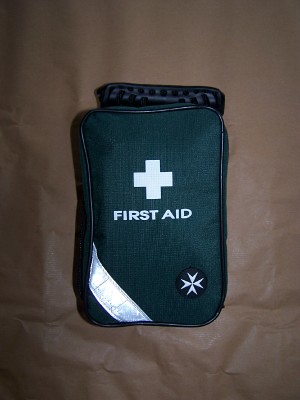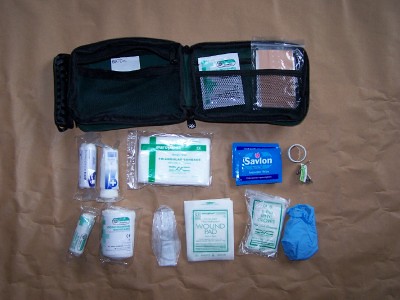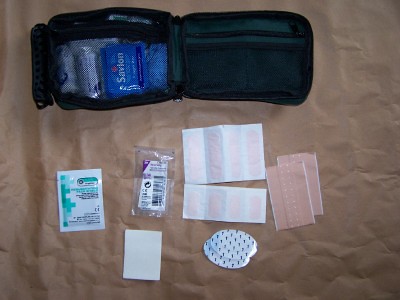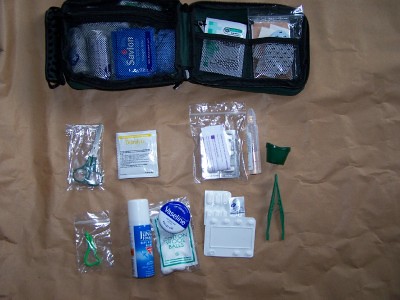Well, being laid up, I have been giving some kit a needed overhaul. I decided to overhaul my small personal First Aid Kit. I have an even smaller version for short walks and a larger group sized one but this is my overnight / weekend size.
Since there have been some threads about first aid recently, I thought I would show what I carry. Im not suggesting this is a perfect formula, its just what I have put together based on things that have happened over the years.
From a philosophy point of view, I guess this is intended to deal with small to medium incidents no huge ambulance dressings or FFDs etc. I do sometimes carry an FFD in a pocket, but generally something can be improvised with a wad of cloth and a conforming bandage in any case.
Size wise I guess its about the size of a paperback book. Here it is

I like this design (available from St Johns Ambulance) as the all round zip allows it to open out giving easy and clear access to a number of separate compartments.

I tend to put things together by need. The left hand large pocket is for wounds, the open pockets for nicks and blisters and the right hand pocket for tools and miscellaneous stuff.
Heres the wound pocket contents

Two (#8) medium wound dressings. I find these make a very flexible combination they seem to be used mostly for limbs and hands. One forms a pad and the other can be wrapped over the top. Good for hands, arms and legs.
One (#16) eye pad. I have seen several minor but painful eye injuries. Sparks, branches etc. all seem to seek them out.
One triangular bandage. I love these things. Good for sling, head wounds and have been used for bandanas to cover sunburned necks padding for bergan strap rubbed areas etc.
One 7.5cm conforming bandages good for minor sprains and strains on ankles and wrists but can also team up with the triangular to make a large dressing
Four 5cm melolin wound pads. Good for scrapes, grazes, smaller burs anything sore that needs covering.
One disposable plastic finger stall. Its always fingers isnt it? So these cost pennies but keep a cut finger clean and supported. I like them.
Roll of micropore tape. Plasters never stick and this is also useful for securing the pads over grazes etc.
A dozen safety pins good for bandages, torn clothes, digging out splinters etc. Useful things
Antispetic wipes. I buy good ones (Savlon) and keep plenty so much easier than liquids and creams.
Gloves a nitrile pair and a sealed vinyl pair. I have abandoned latex as BB is allergic. More for keeping me out of the wound than the wound out of me although both are good!
Next the quick access pouches

On the left I keep a disposable resus shield. Never needed it yet .touch wood!
On the right a small ziplock full of plasters in various types. My most used item so I keep a variety and all quality ones. I prefer fabric types as they seem to stick better.
In the pack there are.
Four long plasters for fingers
Four small plasters for nicks
Two gel plasters designed to cushion blisters
Two longer plasters that I can cut for knuckles, fingertips etc.
A large patch of synthetic moleskin for rubs and blisters.
A pack of mixed steri strips for deeper cuts
Lastly the odds and ends pocket

In here we have
Small clean pair of scissors useful for cutting plasters etc to fit. Kept clean
Both sizes of tick hook cost a couple of quid and a must have for bushcraft in my view
Two packets of dehydration salts. Diarrhoea can wipe you out fast. These are so useful for combating the worst effects. A useful addition if eating unusual or wild foods.
Bite spray. No repellent here because I pack that separately. Bushbaby can react to bites so its a must carry item.
Small can of Vaseline. Useful for windburn, chapped lips etc. A few cotton wool balls in case I need some tinder! I dont like them in wounds as they leave strands behind so I use melolin pads for cleaning.
Tablets Immodium plus same reason as to salts. Strong and normal analgesics. A strip of antihistamines for bites and stings.
A sealed ampoule of saline and an eye bath. Useful for midge in the eye, branch whipped face, flying sparkitis etc. The saline can also be used for irrigating cuts.
Tweezers. For those thorn and splinter moments.
Thats it. Not too fancy and based around my needs. Its no paramedics grab bag but it is small enough to keep handy. Hopefully thats interesting to someone.
Red
Since there have been some threads about first aid recently, I thought I would show what I carry. Im not suggesting this is a perfect formula, its just what I have put together based on things that have happened over the years.
From a philosophy point of view, I guess this is intended to deal with small to medium incidents no huge ambulance dressings or FFDs etc. I do sometimes carry an FFD in a pocket, but generally something can be improvised with a wad of cloth and a conforming bandage in any case.
Size wise I guess its about the size of a paperback book. Here it is

I like this design (available from St Johns Ambulance) as the all round zip allows it to open out giving easy and clear access to a number of separate compartments.

I tend to put things together by need. The left hand large pocket is for wounds, the open pockets for nicks and blisters and the right hand pocket for tools and miscellaneous stuff.
Heres the wound pocket contents

Two (#8) medium wound dressings. I find these make a very flexible combination they seem to be used mostly for limbs and hands. One forms a pad and the other can be wrapped over the top. Good for hands, arms and legs.
One (#16) eye pad. I have seen several minor but painful eye injuries. Sparks, branches etc. all seem to seek them out.
One triangular bandage. I love these things. Good for sling, head wounds and have been used for bandanas to cover sunburned necks padding for bergan strap rubbed areas etc.
One 7.5cm conforming bandages good for minor sprains and strains on ankles and wrists but can also team up with the triangular to make a large dressing
Four 5cm melolin wound pads. Good for scrapes, grazes, smaller burs anything sore that needs covering.
One disposable plastic finger stall. Its always fingers isnt it? So these cost pennies but keep a cut finger clean and supported. I like them.
Roll of micropore tape. Plasters never stick and this is also useful for securing the pads over grazes etc.
A dozen safety pins good for bandages, torn clothes, digging out splinters etc. Useful things
Antispetic wipes. I buy good ones (Savlon) and keep plenty so much easier than liquids and creams.
Gloves a nitrile pair and a sealed vinyl pair. I have abandoned latex as BB is allergic. More for keeping me out of the wound than the wound out of me although both are good!
Next the quick access pouches

On the left I keep a disposable resus shield. Never needed it yet .touch wood!
On the right a small ziplock full of plasters in various types. My most used item so I keep a variety and all quality ones. I prefer fabric types as they seem to stick better.
In the pack there are.
Four long plasters for fingers
Four small plasters for nicks
Two gel plasters designed to cushion blisters
Two longer plasters that I can cut for knuckles, fingertips etc.
A large patch of synthetic moleskin for rubs and blisters.
A pack of mixed steri strips for deeper cuts
Lastly the odds and ends pocket

In here we have
Small clean pair of scissors useful for cutting plasters etc to fit. Kept clean
Both sizes of tick hook cost a couple of quid and a must have for bushcraft in my view
Two packets of dehydration salts. Diarrhoea can wipe you out fast. These are so useful for combating the worst effects. A useful addition if eating unusual or wild foods.
Bite spray. No repellent here because I pack that separately. Bushbaby can react to bites so its a must carry item.
Small can of Vaseline. Useful for windburn, chapped lips etc. A few cotton wool balls in case I need some tinder! I dont like them in wounds as they leave strands behind so I use melolin pads for cleaning.
Tablets Immodium plus same reason as to salts. Strong and normal analgesics. A strip of antihistamines for bites and stings.
A sealed ampoule of saline and an eye bath. Useful for midge in the eye, branch whipped face, flying sparkitis etc. The saline can also be used for irrigating cuts.
Tweezers. For those thorn and splinter moments.
Thats it. Not too fancy and based around my needs. Its no paramedics grab bag but it is small enough to keep handy. Hopefully thats interesting to someone.
Red

 comments). I was told several years ago that the best thing to do (after taking the heat out of the wound) , as a quick fix, would be to cover the entire burn area in plastic - if you have to use cling-film make sure you leave an inch of the end folded back on itself so you can easily find it again! and seal it (REMEMBER: sealing the mouth/nose area can lead a more serious condition known as death), the reason being is that as plastic is non porous it not only stops nasties getting in it's also easier to remove as it will have kept the wound 'gooey'. The plastic can then be removed to allow cleaning/cooling and be reapplied if necessary. Professional treatment for serious burns will most likely include a broad-based anti-biotic to help the body fight the lil'nasties in the patients' system. To end - I'm not medically qualified so please check the validity of this post and if I'm wrong - tell me!
comments). I was told several years ago that the best thing to do (after taking the heat out of the wound) , as a quick fix, would be to cover the entire burn area in plastic - if you have to use cling-film make sure you leave an inch of the end folded back on itself so you can easily find it again! and seal it (REMEMBER: sealing the mouth/nose area can lead a more serious condition known as death), the reason being is that as plastic is non porous it not only stops nasties getting in it's also easier to remove as it will have kept the wound 'gooey'. The plastic can then be removed to allow cleaning/cooling and be reapplied if necessary. Professional treatment for serious burns will most likely include a broad-based anti-biotic to help the body fight the lil'nasties in the patients' system. To end - I'm not medically qualified so please check the validity of this post and if I'm wrong - tell me!